

|
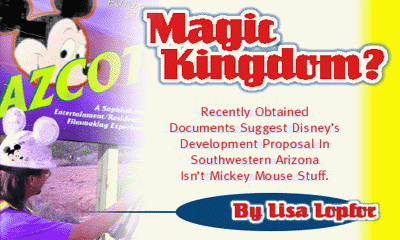
Editor's note: As this issue of the Tucson Weekly was to go to press,
attorneys for the Disney Corporation threatened litigation if publication proceeded:
"The Disney Corporation asserts sole ownership of the documents said to be in
possession of the Tucson Weekly," wrote attorney Robin Widdoes. "Quoting,
summarizing, or in any way indicating the contents of these alleged documents
(should they actually belong to Disney) could result in adverse publicity that
could damage my client's ability to complete a project in which a substantial
investment has already been made. Accordingly, if you do not cease and desist
with your 'investigation,' Disney will pursue all options of grievence,
including but not limited to a lawsuit to recover potential profits, which are
expected to exceed several billion dollars."
The Weekly, which broke no laws in acquiring the information on which the
following story is based, believes this attempt at prior censorship is
unconstitutional, and therefore is proceeding with publication.
SPEND A FEW hours bouncing around the cab of his '74 Ford
3/4-ton pickup and you start to understand why Kokopelli County
Supervisor Randy "Hoof" Bergman has won five consecutive
elections. As he speeds along the county's dirt roads, kicking
a cloud of dust in, spilling a lifetime of memories of people
and places.
"That's the old Twain ranch," he mumbles around a well-chewed
cigar. "I worked for him in my teenage years. Some of my
fondest memories. Over there's the Swift spread. They're my wife's
folks. We've been sweethearts since second grade--meant for each
other, I guess."
You get the sense Bergman knows everyone in Kokopelli County,
population 53,000. The county, located northwest of Pima County,
covers more than 600 square miles of harsh Sonoran Desert that
rises in one corner into Mount Warren, a spectacular pine-studded
"sky island."
 Bergman knows this stunning land and its people. He'll chew the
fat with a dozen or more locals in the course of an afternoon.
Nothing much seems to get said in these sessions of aimless jawboning,
but somehow Bergman comes away knowing exactly what's on everybody's
mind.
Bergman knows this stunning land and its people. He'll chew the
fat with a dozen or more locals in the course of an afternoon.
Nothing much seems to get said in these sessions of aimless jawboning,
but somehow Bergman comes away knowing exactly what's on everybody's
mind.
But ask him about Disney, and suddenly Bergman grows terse.
"Shazam! A rumor sure can fly," Bergman says. "You
media types will believe just about anything, won't you?"
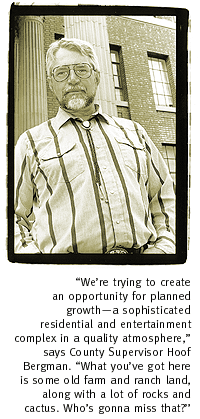 BERGMAN isn't the only one who clams up when asked about
the Disney corporation. While they admit a deal's in the works,
his colleagues on the Kokopelli County Board of Supervisors aren't
commenting. State officials and real estate brokers are equally
evasive.
BERGMAN isn't the only one who clams up when asked about
the Disney corporation. While they admit a deal's in the works,
his colleagues on the Kokopelli County Board of Supervisors aren't
commenting. State officials and real estate brokers are equally
evasive.
Despite the stonewall, sketchy details of an extraordinary plan
were leaked last month to the Tucson Weekly. The package,
which appears to be a mix of correspondence, planning blueprints
and official memos from Kokopelli County, the Arizona Land Department
and the Disney Corporation, show the Kokopelli County Board of
Supervisors is deep in negotiations with Disney to develop the
most ambitious master-planned community in the history of the
state, if not the world. Code-named AZCOT, the plan appears to
be a 21st-century version of Disney's EPCOT (Experimental Community
of Tomorrow) Center in Orlando, Florida. Under the proposal, Disney
would acquire title to roughly 600 square miles in Kokopelli (see
map, page 17). Kokopelli County supervisors would then relinquish
control of the area to an "Entertainment Improvement District"
(EID) controlled by a three-member board of directors that would
be appointed by the Disney Corporation.
This EID would assume nearly all the duties of the Board of Supervisors.
It would control the county's budget, tax rate, zoning decisions,
law-enforcement duties, judicial system, welfare administration
and indigent healthcare. (As one memo explains, "Many of
these departments would benefit from a profit-minded approach.
For too long, government programs like welfare have been treated
like social services.") The supervisors, using a budget provided
by the EID, would continue handling constituent complaints and
retain the power to issue proclamations.
In return, Disney would build a $6 billion theme park covering
150 square miles. Twice the size of any previous Disney park,
Disney AZ will include all of the corporate giant's signature
attractions--the Matterhorn, Pirates of the Carribean, Main Street
USA and the like--as well as accommodating many new and ambitious
attractions, such as:
- A simulated Colorado River adventure, featuring raft-like
carts which travel on submerged rails through a 1/4-scale fiberglass
replica of the Grand Canyon;
- A cliff-dweller city featuring animatronic Anasazi grinding
corn and weaving baskets;
- The largest Old West attraction ever devised: Duckville,
a frontier town so expansive that if it were real, it would be
the seventh-largest city in Arizona, complete with covered-wagon
monorail and a complex municipal stagecoach system.
In addition, the company will construct 250 golf courses and
film, television and animation studios, as well as a robotics
lab designed to develop service units for use in the park.
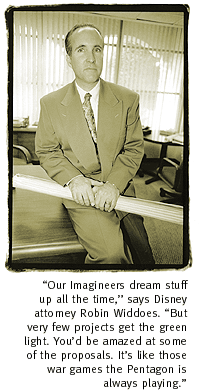 "If such a project were to be built--and of course we have
no guarantees at this point--it would mean thousands of service-industry
jobs for Arizonans!" said Al Spinnitt, a spokesman for Gov.
Jane Dee Hull's administration.
"If such a project were to be built--and of course we have
no guarantees at this point--it would mean thousands of service-industry
jobs for Arizonans!" said Al Spinnitt, a spokesman for Gov.
Jane Dee Hull's administration.
Disney initially brushed off questions about the plan's authenticity.
Questions were directed to Disney counsel Robin Widdoes, who laughed
heartily when asked if the development plans were genuine. "Oh,
our Imagineers dream stuff up all the time. That's their job.
But very few projects get the green light. You'd be amazed at
some of the proposals. It's like those war games the Pentagon
is always playing."
But just as The Weekly was going to press, the Mickey
Mouse corporation started whistling a different tune, and it wasn't
a happy one. Widdoes demanded the documents be returned to Disney,
in a letter claiming their "potential ownership."
The documents in question reveal the astonishing theme-park project
is just the beginning of Disney's vision for Kokopelli County.
Disney's development arm, working with a team of the company's
famed Imagineers, has proposed constructing millions of homes
built according to six design styles. These homes will be spread
across environmentally engineered "townships."
"While the climate is excellent, our research shows that
many potential future residents--particularly retirees from more
temperate parts of the country--find the Sonoran Desert environment
inhospitable," one report reads. "Simply put, people
will be more comfortable in familiar surroundings."
Disney proposes to raze large tracts of the desert and create
a variety of American regional environments throughout Kokopelli
County. "With an aggressive desert relocation program followed
by an accelerated eco-grafting operation, we believe it is possible
to create lush Northwestern forests, Kansas prairies, lakeside
communities, Louisiana bayous and a host of other living environments,"
the report states.
Each of these "regions" would include scaled-down "UrbanMocks™"
of specific metropolitan areas surrounded by a ring of suburbs.
"We have a unique opportunity to recreate the best elements
of our country's greatest cities in an environment where the sun
shines nearly every day," one memo boasts. "Imagine
a Manhattan with the Empire State Building, Radio City Music Hall,
a thriving theatre district and an outstanding collection of ethnic
restaurants, but no wailing car alarms, no muggings, no ethnic
population, no urban woes."
In a revolutionary marketing agreement with fast-food giant McDonald's,
each UrbanMock™ is slated to feature a series of drive-thru
restaurants iconically shaped for the leading landmark of its
model city: Fenway Park for McBoston, the Statue of Liberty for
McYork (a.k.a., the Big McApple), the Space Needle for McSeattle,
and so on. (McAngeles was cut from the list when Anaheim-based
Imagineers expressed doubts that L.A.'s "unique nature"
could be recreated in the project.)
 ASK HOOF BERGMAN about these plans, and you get a good
laugh--but few details.
ASK HOOF BERGMAN about these plans, and you get a good
laugh--but few details.
"Well, we're in talks with a developer and I really can't
comment," Bergman says. "All I can say is that we're
trying to create an opportunity for orderly, planned growth--a
sophisticated residential and entertainment complex in a quality
atmosphere. What you've got out here is some old farm and ranch
land, along with a lot of rocks and cactus. Who's gonna miss that?"
Sandahl Crane sure will. Crane, staff attorney for the Center
for Ecological Litigation, is horrified by the prospect. "You're
talking about transforming a big chunk of the Sonoran Desert into
forests, lakes, swamps and suburbs," she protests. "Golf
courses are bad enough, but they want scaled-down Lake Michigans
and Hudson Rivers!"
But water isn't a worry for Disney. Along with existing water
rights, the developers suggest they could win Tucson's CAP allotment.
"Tucsonans continue to reject CAP water," the report
notes. "By assuming responsibility for the water, we can
solve one of Tucson's problems--what to do with CAP water--while
assuring our future needs. It's a win-win situation." The
report also notes that Tucson's growth will probably slow once
most high-paid jobs and affluent citizens relocate to AZCOT.
The water plan hardly pacifies Crane. "The environmental
devastation would be unparalleled and the long-term results would
be catastrophic. There are some natural wonders in Kokopelli County
like Scattrail Canyon and Tumblebelly Creek, which are home to
endangered species like the hucklebellied grouter and the Sonoran
sandfly."
Crane promises her group will sue under the Endangered Species
Act to stop the development from going forward. But Disney's legal
arm has already anticipated that move. According to the documents,
Disney has a plan to innoculate itself against a lawsuit under
the ESA, even though it anticipates pushing several indigenous
species toward extinction. "We can make this work to our
benefit," a confidential legal document reads. "Federal
environmental dollars are available to set aside habitat for impacted
species. We believe we can enter into a pre-emptive Multi-Species
Habitat Conservation Plan that will provide millions of dollars
in matching federal funds and insulate us against costly future
litigation." The plan envisions creating a 300-acre "Sonoran
Wildlife Refuge" and resort complex for these endangered
species. "In exchange for this generous set-aside, the Department
of the Interior will match admission fees from eco-tourists with
federal dollars."
But that's just the beginning of the subsidies the project's
planners hope to draw. Virtually all of the land in question is
currently owned by the state Land Department. Charged by the Arizona
Constitution with the responsibility of selling land for its "highest
and best use," with proceeds earmarked for public education,
the Land Department generally sells state land for development,
and often works with developers who eventually purchase the land.
According to what appears to be an inter-office Land Department
memo, Disney would instead take out an "option" on the
land. It would be leased to Disney for nothing, which would relieve
the corporation from ever paying property taxes. Homeowners and
businesses in the development, however, would be charged a fee,
called a "Property Tax Equivalency," which would be
collected by Disney in exchange for its participation in the project.
According to the memo, "The land may never be developed
without the financial investment of a developer like The Client.
The long-range fiscal ripple will more than compensate for what
initially might appear to be a less-than-equitable exchange."
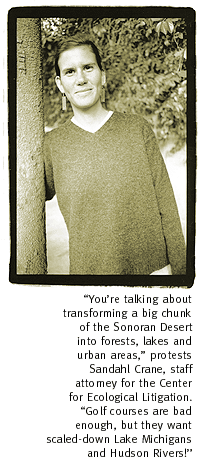 Although Land Department spokesman Tom Knotelling admits the
deal is currently in the planning stages, he refused to disclose
details, claiming the arrangement was protected from public scrutiny
by "government-client privilege."
Although Land Department spokesman Tom Knotelling admits the
deal is currently in the planning stages, he refused to disclose
details, claiming the arrangement was protected from public scrutiny
by "government-client privilege."
The few privately held ranches and farms in the proposed area
have been recently purchased by a what appears to be a number
of "dummy" corporations, including MVI (Mouse Ventures
Inc.), DPI (Duck Properties Inc.) and GPI (Goofy Development Inc.).
EVEN WITH THE low-cost land, the project's tab will still
stretch to eight figures. To offset the cost, the development
calls for an infusion of federal, state and local tax dollars,
according to a memo written by Annie Metronik, an assistant Kokopelli
County manager. Although Metronik didn't return phone calls from
The Weekly, a 1998 article in the Buffeltown Herald-Prevaricator
reported she was hired by the county one year ago, in a new position
made possible by a grant from the Disney Corporation.
In her report, Metronik justified the use of tax dollars for
economic development. "Although on the surface it seems as
though the project will consume tax dollars earmarked for other
areas in the state," Metronik wrote, "the 'multiplier
effect' from the project over the next several decades clearly
shows that this government investment will be paid off a million-fold
in the centuries to come."
Among the proposed taxpayer contributions:
- Roads will be built with funds diverted from school construction
projects around the state.
- A world-class monorail system will be built with state
lottery funds that currently support public bus systems in Tucson
and Phoenix.
- NAFTA funds will be used to extend the monorail to the
Mexican border. (Because the project is within 300 miles of the
border, it's considered a "wage-free zone" under NAFTA.)
The report forecasts bringing workers into the country to fill
jobs in the development at the Mexican minimum wage until a "robotics-based
service community" can be created.
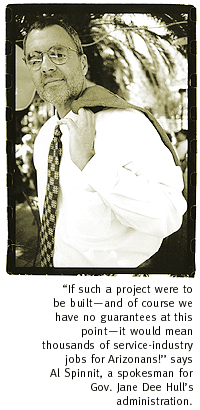
- Sewer lines will be built with federal funds. Planners
hope to win dollars earmarked through NAFTA for environmental
clean-ups. According to the documents, "This wise investment
of funds will pay dividends in the 22nd century, when advances
from this state-of-the-art technology can be retrofitted in border
communities like Nogales."
- Disney will acquire leases to harvest nearly all of the
timber atop Mount Warren. The U.S. Department of the Interior
will build roads criss-crossing the mountain, while Disney will
receive all logging revenues.
- Recreational fees from national forests, including Mount
Lemmon and Sabino Canyon, will be diverted to Disney's proposed
Bambi's Woods, a family-friendly, faux forest composed entirely
of fire-retardant, non-injurious materials to be built atop Mount
Warren following the timber harvest. The usual pine-needle base,
which can often injure children with its sharp points, would be
replaced with a deep layer of brightly colored foam balls.
- According to several documents in The Weekly's
possession, the entire project will be powered by a combination
of solar and nuclear technology. "Federal grant monies available
for solar power continue to grow," one Disney analyst observes.
"Even though solar technology is inadequate for intensive
urban entertainment development, these federal funds are increasingly
available for properly structured corporate ventures."
Another document indicates Disney planners believe they can take
advantage of a U.S. Department of Defense program aimed at increasing
the safety of Russia's nuclear stockpile. "By operating in
accordance with DOD's Project Cooldown," the memo states,
"the sale and/or leaseback of former Soviet breeder reactors
becomes an attractive and reasonable supplement to conventional
solar power sources. The federal government will waive importation
fees under the category Educational Materials and Displays."
The plan taps revenue sources heretofore unimagined, even calling
for the sale of naming rights for streets in the development.
"Previously, street names have been haphazardly chosen by
developers," the report says. "However, we believe many
corporations would find sponsorship to be an excellent marketing
opportunity. The private investor will not be excluded: Individuals
can participate by purchasing the privilege to have have their
street named for themselves, their families, or in memory of a
loved one." Estimated revenue: $120 million.
UP AT THE state Capitol, the halls are buzzing with stories
about the project, but lawmakers decline to comment on the record
(although several were quick to deny rumors which surfaced last
week that they have been quietly forming private corporations
to bid on various aspects of the secret Disney plans).
But take a look at House Bill 2899, which started out as a simple
measure to name the state's new $700 million treasury building
after former Gov. J. Fife Symington III. The bill was subsequently
amended to include many provisions that would aid the fledgling
development.
Among the provisions:

- The bill would lay the groundwork for the creation of
an Entertainment Improvement District.
- This Entertainment Improvement District would be able
to form a charter school district--one of Disney's key plans.
As one leaked memo reads, "We believe by combining traditional
educational tools with Disney's extensive stable of beloved characters,
we can create the happiest classroom on earth."
- By treating the anticipated amusement park attendance
figures as a calculation of population density, the proposed legislation
would secure a large percentage of the state's urban renewal and
inner-city improvement funds.
- The bill would allow the theme park's snack bars and soda
stands to be partly underwritten by WIC, the Women, Infant and
Children nutrition program. This will allow Disney to sell, for
example, hamburgers for only $9.50, rather than the $10 unsubsidized
price at the California and Florida parks.
HB 2899 is being pushed by powerful lobbyist Wesley Krooke, who
downplays the legislation's effect. "It really just clarifies
some holes in the law," says Krooke, who declined to tell
The Weekly which of his many clients he was helping with
the bill. But he recently added a group called "Arizonans
For Theme Park Development" to his list of clients at the
Secretary of State's Office.
Glenn Buttkiss, the director of Arizonans for Theme Park Development,
says theme parks will help boost the state's economy.
"We're just a grass-roots group," says the 37-year-old
Buttkiss, a former Disney executive who retired to Arizona six
months ago. "We have thousands of members throughout the
state who agree that theme parks are vital to maintaining the
state's tourism edge."
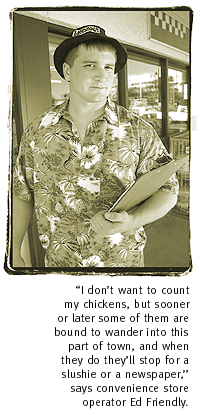 Buttkiss scoffs at claims by astronomers on Mount Warren, who
gripe that light pollution from the development would destroy
their billion-dollar telescope array, in place for more than 30
years.
Buttkiss scoffs at claims by astronomers on Mount Warren, who
gripe that light pollution from the development would destroy
their billion-dollar telescope array, in place for more than 30
years.
"What's more important," Buttkiss asks, "some
distant galaxy, or the happy smile on a child's face after his
dream of visiting Disneyworld has come true?"
Beyond the economic impact of the theme park, Buttkiss says a
proposed film studio could generate revenues for the state.
Critics complain Disney is deliberately withholding most of the
plans while dropping hints about the movie studio to build support
for the project. And it seems to be working:The people in Kokopelli
County are excited by Tinseltown glamour. Freelance signpainter
Wanda Paicheck could hardly contain her enthusiasm for the idea.
"I mean, of course they'll bring in all their own actors,
crew, construction teams and support people, but they'll need
extras sometimes."
Convenience store operator Ed Friendly agrees. "I don't
want to count my chickens, but sooner or later some of them are
bound to wander into this part of town, and when they do they'll
stop for a slushie or a newspaper."
But Friendly may be in for a surprise. Disney isn't welcoming
any competition inside its development. While planners hope local
home and business owners will simply sell their property, the
Entertainment District would be able to use the power of eminent
domain to acquire the homes through condemnation.
And while there will be lots of filmmaking activity--Disney hopes
to use the various UrbanMocks™ as backdrops--local residents
will be obligated to appear in movies filmed in their neighborhoods.
"Most people are delighted at the opportunity to play a
part in the creation of a major motion picture," reads one
confidential memo. "However, there are always those residents
who find some reason to object."
To prevent those "bad apples" from ruining things for
everyone else, the report suggests designing CCRs which would
force homeowners to allow filming in their neighborhoods and to
participate in the films as extras, as needed. Additionally, the
Entertainment Improvement District is expected to make it a Class-6
misdemeanor to interfere with filmmakers in any way.
But that's a slap on the wrist compared to the felony charges
the Entertainment District could file against political activists.
Disney seems particularly concerned with protests from environmentalists
(although the memo also expresses concern about radical religious
cults like the Southern Baptists).
"Although this project will only affect 600 square miles,
representing a mere .5 percent of the Sonoran Desert, we can expect
an outcry from the environmental community, which is likely to
object no matter how sensitively we market this project,"
according to a draft memo. "But it will be within the legal
power of the Entertainment District to declare such anti-social
behavior a felony."
The memo proposed incarcerating protestors in an ersatz Alcatraz
off the coast of McFrancisco. Tours would be available for the
public, a plan which would turn environmental activists like Sandahl
Crane into another tourist attraction.
"If I hadn't seen the documents, I don't think I'd believe
this was true," Crane says. "I keep waiting for somebody
to say, 'April Fool's!' "

|
 |





